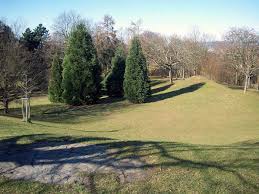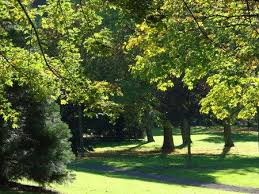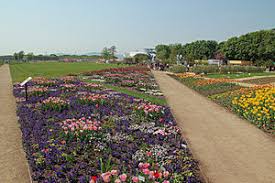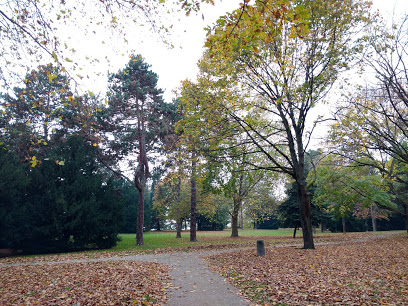The Lützeler Volkspark was built in Petersberg in the Koblenz district in 1932 on Lützel on the remains of the former castle of Bubenheimer Flesche, which eased after World War I in the 1920s, along with other works of the Feste Franz system. The park and cemetery below are framed in the following streets today: Am Volkspark - Bodelschwinghstraße - Am Petersberg - Andernacher Straße - Am Franzosenfriedhof.
On the landscape of an area of approximately 14 acres grew according to the plans of the municipal parks office including remains of castles in the 1930s, a public park, which according to contemporary reports, one of the most beautiful parks in the city of Koblenz. Plans for the establishment of a park in the former fortress area are clearly due to 1921. However, the difficult acquisition negotiations with the Reich and the continued occupation by the French occupation delayed the start of work until 1932 and the city of Koblenz took over the site until 1 January 1934.
Structure and design
To carry out the work in the park, the city first began in July 1932 volunteer service. The working day for participants, mostly young people, including the sponsorship program (sports, training, film shows, etc.) lasted nine to ten hours a day. The work service was initially located in former buildings in the nearby field artillery barracks, where lunch was also served with the food brought with him. Supposedly from October 1932 all participants received a hot meal daily at nearby Trainkaserne. The work was from Monday to Friday, and Saturday was reserved for cleaning equipment and salaries. The measures were limited in the number and duration of participants and were extended several times.
In January 1933, until the end of October 1935, the city also hired a railway to support manual labor mainly. The men cleared the blast sites and settled the area and took the remains of the fort and used the stones later. L Bedding border. The former fortress was repaired and used initially as an office, lounge and warehouse. After the seizure of power by the Nazis, the site of Lützel for construction on April 24, 1933 went to the care of the Society for the retraining of volunteer workers for example, a pioneer of the subsequent Reich labor service. Since then, the procedure has continued in a closed camp, where participants are now in specially designed rooms to manage the former clothing of a corps. Since the remains of the underground castle had partially delayed work, the bombings were resumed in 1934. No remains of the castle still exist underground, so it is difficult to say.
When the service of work at Volkswagen Park has ended and the Municipal Parks Office has assumed an unknown responsibility. Over the course of the entire construction phase, some 1,000 unemployed people worked in the Volkspark, which transferred 110,000 cubic meters of land and broke the area of 11,000 cubic meters of quarried stone on the old fortress and then rebuilt. The total cost of the project, according to Ryan Zeitung reached one million mark. After a four-year construction period, on 13 June 1936, the mayor of the city of Koblenz Vittgen established the official opening of the park, which is not yet completed. On November 18 of the same year, a memorial to war victims was opened in Lützel Turnverein, perhaps built on the grounds of the lower promenade. The former Reduit of the Flesch restaurant has been designed since 1938 in a mortar battery, a winter house for plants. An underground tunnel was built in 1938 to provide shelter for air raids.
Plant description
Shell Fountain.
Today only the photos remind us of the original Volkspark in the 1930s, when the whole complex was redesigned after the war. According to the first plan of the Garden Office of 1921, it must be a combination of sports facilities, recreational facilities and visual objects. In 1924, the plan was handed over to a sports stadium with a cycling track. Both ambitious projects have not benefited because of the poor financial situation of the city.
In the opening of 1936, Mayor Vittgen described the new park as follows: The entire Volkspark complex, [...] is divided into the big midfield in front of Reduit, the large rose garden behind the castle ground, the playground of the comfortable children facing the north with pergola and large stairs, Special in the old ditch, the rock garden at the main entrance and the bird sanctuary in the open forest in the Andernacher Straße. There will also be a model school garden later. In addition, everywhere, there are souvenirs, sculptures and buildings arranged cleverly in the surprise of the world of surrounding plants. One of these paintings was donated with Alexander von Humboldt by the construction service. He said: What nature created in the beauty of eternal awakening, arrange the human in the garden according to the rules of art. The main entrance to the park in Bodelschwinghstraße was today in the direction of Koblenz Station. The tracks at the top of the Volkspark were oval, and then the street route was Am Volkspark. Today's trail from the factory still reminds little of this model.





